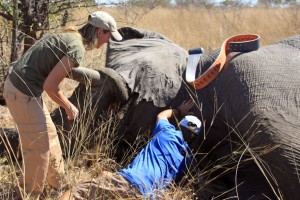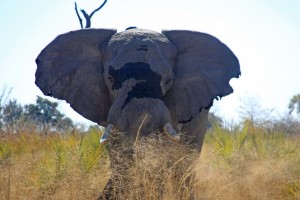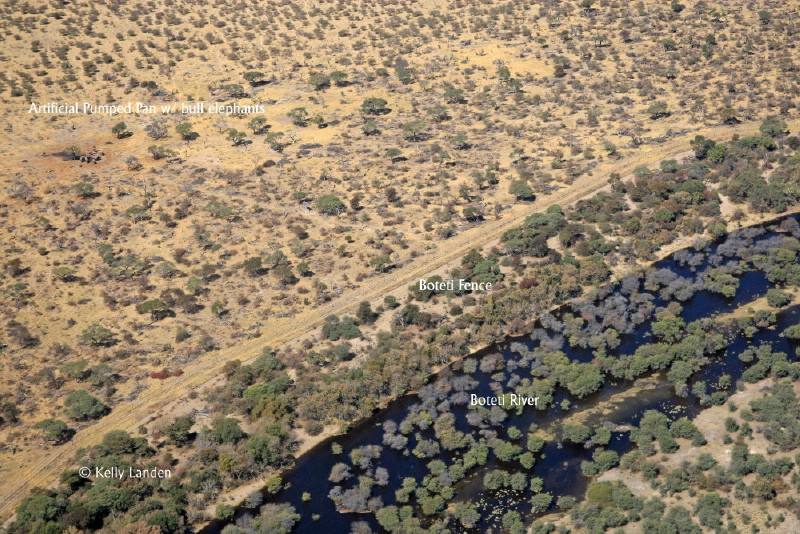Elephant Range Expansion Study update
The elephant range in Botswana has expanded by 65%, during the last 15 years. Using our aerial survey and telemetry data from 55 collared elephants we estimate the current elephant range in northern Botswana to be 138 000 km2. The most noticeable range expansion has occurred south towards the Makgadikgadi and west of the Okavango Delta. In Aug. 2009, EWB collared four elephants in the Makgadikgadi National Park to better understand the southern expansion of the elephant range. (Read the Blog: https://elephantswithoutborders.org/blog/?p=206) The western segment of the elephant range study began when we collared an adult elephant bull, west of Gumare, and an adult elephant cow, along the Southern Buffalo Fence. This month, EWB expanded this segment of our study and collared two elephant bulls on the western fringes of the Okavango Delta. (EWB Tracking: http://www.elephantswithoutborders.org/tracking.php) The first bull we collared is a frisky elephant, approx 30 years of age, named Cavalier. During the first week of monitoring, Cavalier moved steadily north 30km from his collaring location, until he temporarily settled on a small island. This past week he turned south and has almost completed a circle back to his collaring site.

Kelly & Pete fitting a satellite collar

Soldier boy donning his new collar
The other is a much larger, older bull, named Soldier boy that was spotted enjoying palm nuts on the fringes of large dry patches within the delta. Just this week, he crossed a major flooded channel to move east. These 2 bulls will provide us with information which will be added to our satellite telemetry database, improving our understanding of the spatial ecology, and habitat use of elephants on the western periphery of their range. This collaring exercise was made possible with the generous financial support received from Mr. Harry Ferguson and Mr. Rob Barrie. We extend our thanks to Dr. Cyril Taolo and Department of Wildlife and National Parks personnel, the Department of Civil Aviation, Mike Holding, Larry Patterson, Peter Perlstein and John Sobey and the staff of African Horse Back Safaris for hosting us at their camp. On a personal note, I also wanted to thank everyone at AHS for allowing me to join them on a horseback ride in the delta! It was so invigorating when the horses cantered, leaping high and fast through the waters. I held tight, and was completely soaked from head to toe, but couldn’t help but keep a huge smile on my face. An experience I highly recommend. African Horseback Safaris http://www.africanhorseback.com/
Following the collaring exercise, EWB spent the day flying in a Cessna to track and visually check on the elephants collared as part of the same range expansion study. Luckily we had an idea where we might find them due to their last satellite locations, but it is always surprising to see the type of environment and who the elephants may be roaming with. Initially it was difficult to pinpoint the first elephant we were tracking, Naledi, as he was in the harsh, dry extent of the Makgadikgadi, where many bulls were roaming. We narrowed in on a large herd of 18 bulls that seemed to give off a strong signal, however we could not find the collar. We circled and circled insisting that he must be among them. However, on a turn, Mike spotted 3 other elephants just a small distance away and sure enough, we found our bull. Pulling higher into the air, we headed south in hopes to get a visual on Xhumaga. At one point, we were astounded by a sight below: nearly 30 bull elephants were rousting for a turn at a trough in an artificial waterhole. The pumped pan was nothing more than a small mud puddle. Many definitive paths led to it, indicating its high daily usage and importance to the bulls. We know these artificial water points were set into place and started pumping just last year, but the vegetation surrounding the pan was almost completely destroyed already. What astounded us most was the proximity of the now flowing Boteti River to this pan. Approx 100 meters away, a 2.2 meter high, electrified fence separated the bulls from reaching the river’s fresh, clean water. The fence was put into place to avoid conflict from wildlife into the villages.

Aerial: Eles at pan, fence, river
The river had not been flowing this far south at the time the fence was erected and when it was constructed a few points were alloted for the wildlife to access the river. However, the wildlife’s access points are far and few between. What seems obvious to us now, is that perhaps it is time for the management plan in this region and the fence alignments, both should be reconsidered. (To download articles, publications and elephant movement maps from EWB: http://www.elephantswithoutborders.org/downloads.php) We kept going south and finally found our bull at the southern most point of the fence line, trapped from moving any further south or west towards the water. We plugged on and we received another signal to the west. The signal kept getting stronger and stronger, but no elephants were in sight. As we drew closer to the waters of Lake Ngami, we spotted a breeding herd and a few bulls scattered amongst a forest of Russet bush willow trees. IN a few short moments, he was easily spotted. Perplexing, we had received a VHF signal from Kwebe 70 kilometers away! Normally, the signal strength is by “line of sight” and even from a small plane is usually 40-50km, at best. Satisfied for the day’s event, but running low on fuel, we headed back to land in Maun. (To support EWB’s projects and activities: http://www.elephantswithoutborders.org/donate.php)

Okavango Delta collared bulls' 2 weeks movements
Tags: africa, artificial waterholes, botswana, conservation, delta, elephants, Makgadikgadi, research







